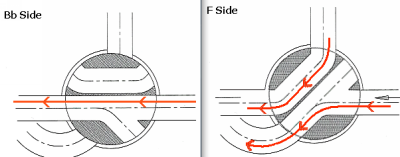Page 1 of 1
C. Lindbergh valve question
Posted: Sun Jul 14, 2013 8:38 pm
by imperialbari
Via a current thread I saw this for the first time:

The drawings don't tell whether the airpath(-s) are in one single plane or whether there is some offsetting of planes in play. I only can imagine a proper alignment of ports, if the airpaths are in one and the same plane.
Does that imply that the Bb as well as the F airpaths have a dead end length of tubing while they pass through the rotor?
If so, why have inventors of alternative water keys worked hard to avoid the much smaller volumes of dead end tubing associated with traditional water keys?
In my interpretation the Lindbergh valve introduces a source of turbulence. A phenomenon not really liked in aviation nor in music.
Klaus
Re: C. Lindbergh valve question
Posted: Sun Jul 14, 2013 10:54 pm
by MartyNeilan
I know trombone guys (mostly hardcore orchestra) who swear by Thayers. I also know others who won't use anything but a traditional style

rotor (including various brands' tweaked versions). I even know a couple who like the totally different newer "Shires" valve (Thayer guys usually don't).
I have never met anyone who has actually liked the CL valve after spending any time on one. I believe the same can be said for the old Bach K valve.
Re: C. Lindbergh valve question
Posted: Sun Jul 14, 2013 11:00 pm
by imperialbari
MartyNeilan wrote:I know trombone guys (mostly hardcore orchestra) who swear by Thayers. I also know others who won't use anything but a traditional style

rotor (including various brands' tweaked versions). I even know a couple who like the totally different newer "Shires" valve (Thayer guys usually don't).
I have never met anyone who has actually liked the CL valve after spending any time on one. I believe the same can be said for the old Bach K valve.
Never tried a CL valve, but as hinted the very concept to me looks like something makers have worked hard to avoid. So why introduce something bound to cause a less than ideal acoustics?
Klaus
Re: C. Lindbergh valve question
Posted: Sun Jul 14, 2013 11:12 pm
by Jayhawker
The purpose of the Lindberg valve is to help facilitate in solo playing. The "throw" of the valve is almost nothing, whereas traditional rotors and Thayer valves have considerably longer "throws".
Lindberg designed the valve to be short and fast, not to help airflow. That being said, I swear by thayers! Some people I know LOVE the Lindberg valve, and I just can't get behind them.
So there you go, hope this helps!
Re: C. Lindbergh valve question
Posted: Mon Jul 15, 2013 2:15 am
by Doug Elliott
I don't own one but I've tried them. They play surprisingly OK despite the dead space, and I haven't been aware of any particular bad notes. I guess there's never a node that lines up with it. I know people who have those horns and like them.
Re: C. Lindbergh valve question
Posted: Mon Jul 15, 2013 10:19 am
by windshieldbug
Remember that air doesn't really flow through a horn much, notes are actually sounded actually the harmonic nodes that are excited by and amplify the mouthpiece buzzing. Only if a particular node is in that exact place will it be modified.
Thus, there are people who claim that some "dents" have an impact on their intonation.
The alternative water keys minimize any potential impact due to placement in the bore profile, but that is also modified by player, mouthpiece, etc. so the combinations are endless.
It will have no effect on most notes. It may help or hurt the few that it does affect.
On my slant-rotor Marzan I removed the main water key and filled it in flush with the tubing after testing it temporarily blocked back in the '80s. It improved my bottom line G. I had a pitch counter that said so, anyway...

